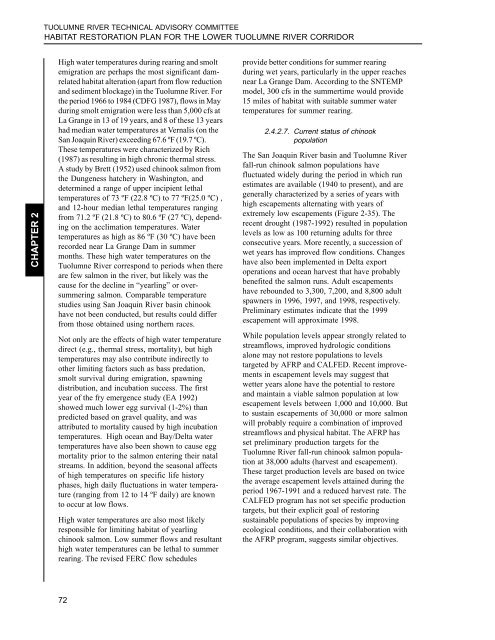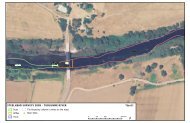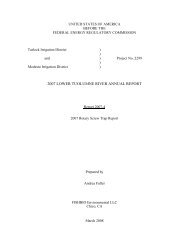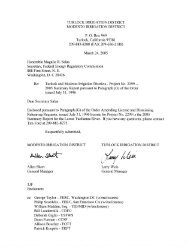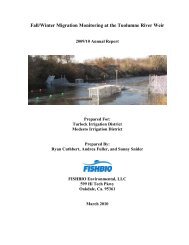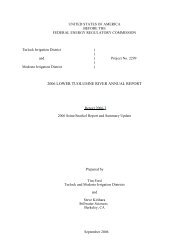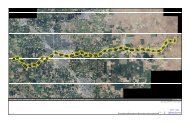TUOLUMNE RIVER TECHNICAL ADVISORY COMMITTEEHABITAT RESTORATION PLAN FOR THE LOWER TUOLUMNE RIVER CORRIDORCHAPTER 2High water temperatures during rearing <strong>and</strong> smoltemigration are perhaps the most significant damrelatedhabitat alteration (apart from flow reduction<strong>and</strong> sediment blockage) in the <strong>Tuolumne</strong> <strong>River</strong>. Forthe period 1966 to 1984 (CDFG 1987), flows in Mayduring smolt emigration were less than 5,000 cfs atLa Grange in 13 of 19 years, <strong>and</strong> 8 of these 13 yearshad median water temperatures at Vernalis (on theSan Joaquin <strong>River</strong>) exceeding 67.6 ºF (19.7 ºC).These temperatures were characterized by Rich(1987) as resulting in high chronic thermal stress.A study by Brett (1952) used chinook salmon fromthe Dungeness hatchery in Washington, <strong>and</strong>determined a range of upper incipient lethaltemperatures of 73 ºF (22.8 ºC) to 77 ºF(25.0 ºC) ,<strong>and</strong> 12-hour median lethal temperatures rangingfrom 71.2 ºF (21.8 ºC) to 80.6 ºF (27 ºC), dependingon the acclimation temperatures. Watertemperatures as high as 86 ºF (30 ºC) have beenrecorded near La Grange Dam in summermonths. These high water temperatures on the<strong>Tuolumne</strong> <strong>River</strong> correspond to periods when thereare few salmon in the river, but likely was thecause for the decline in “yearling” or oversummeringsalmon. Comparable temperaturestudies using San Joaquin <strong>River</strong> basin chinookhave not been conducted, but results could differfrom those obtained using northern races.Not only are the effects of high water temperaturedirect (e.g., thermal stress, mortality), but hightemperatures may also contribute indirectly toother limiting factors such as bass predation,smolt survival during emigration, spawningdistribution, <strong>and</strong> incubation success. The firstyear of the fry emergence study (EA 1992)showed much lower egg survival (1-2%) thanpredicted based on gravel quality, <strong>and</strong> wasattributed to mortality caused by high incubationtemperatures. High ocean <strong>and</strong> Bay/Delta watertemperatures have also been shown to cause eggmortality prior to the salmon entering their natalstreams. In addition, beyond the seasonal affectsof high temperatures on specific life historyphases, high daily fluctuations in water temperature(ranging from 12 to 14 ºF daily) are knownto occur at low flows.High water temperatures are also most likelyresponsible for limiting habitat of yearlingchinook salmon. Low summer flows <strong>and</strong> resultanthigh water temperatures can be lethal to summerrearing. The revised FERC flow schedulesprovide better conditions for summer rearingduring wet years, particularly in the upper reachesnear La Grange Dam. According to the SNTEMPmodel, 300 cfs in the summertime would provide15 miles of habitat with suitable summer watertemperatures for summer rearing.2.4.2.7. Current status of chinookpopulationThe San Joaquin <strong>River</strong> basin <strong>and</strong> <strong>Tuolumne</strong> <strong>River</strong>fall-run chinook salmon populations havefluctuated widely during the period in which runestimates are available (1940 to present), <strong>and</strong> aregenerally characterized by a series of years withhigh escapements alternating with years ofextremely low escapements (Figure 2-35). Therecent drought (1987-1992) resulted in populationlevels as low as 100 returning adults for threeconsecutive years. More recently, a succession ofwet years has improved flow conditions. Changeshave also been implemented in Delta exportoperations <strong>and</strong> ocean harvest that have probablybenefited the salmon runs. Adult escapementshave rebounded to 3,300, 7,200, <strong>and</strong> 8,800 adultspawners in 1996, 1997, <strong>and</strong> 1998, respectively.Preliminary estimates indicate that the 1999escapement will approximate 1998.While population levels appear strongly related tostreamflows, improved hydrologic conditionsalone may not restore populations to levelstargeted by AFRP <strong>and</strong> CALFED. Recent improvementsin escapement levels may suggest thatwetter years alone have the potential to restore<strong>and</strong> maintain a viable salmon population at lowescapement levels between 1,000 <strong>and</strong> 10,000. Butto sustain escapements of 30,000 or more salmonwill probably require a combination of improvedstreamflows <strong>and</strong> physical habitat. The AFRP hasset preliminary production targets for the<strong>Tuolumne</strong> <strong>River</strong> fall-run chinook salmon populationat 38,000 adults (harvest <strong>and</strong> escapement).These target production levels are based on twicethe average escapement levels attained during theperiod 1967-1991 <strong>and</strong> a reduced harvest rate. TheCALFED program has not set specific productiontargets, but their explicit goal of restoringsustainable populations of species by improvingecological conditions, <strong>and</strong> their collaboration withthe AFRP program, suggests similar objectives.72
LINKING PHYSICAL PROCESSES AND SALMON LIFE HISTORY2.4.3. <strong>Fish</strong> <strong>and</strong> wildlife resourcesRestoring fundamental fluvial processes thatcharacterized the historical <strong>Tuolumne</strong> <strong>River</strong> maynot only aid in recovery <strong>and</strong> maintenance of achinook salmon population, but will also improveconditions for a wide range of native fish <strong>and</strong>wildlife species. Similar to our description of thechinook salmon’s adaptations to historicalecological conditions, other native inhabitants ofthe aquatic <strong>and</strong> riparian habitats provided by the<strong>Tuolumne</strong> <strong>River</strong> are also adapted to the historically“pristine” conditions that existed prior toextensive degradation of the l<strong>and</strong>scape. InCalifornia, the amphibian, bird, <strong>and</strong> mammalianspecies diversity in Central Valley riparian zonesrepresents the highest biodiversity found anywherein the state (Tietje et al. 1991). Riparian<strong>and</strong> floodplain habitats support at least 50amphibian <strong>and</strong> reptile species, 147 bird species,<strong>and</strong> 55 mammal species (Mayer <strong>and</strong> Laudenslayer1988).From their review of records dating from 1970,Brown <strong>and</strong> Ford (1992) identified 37 fish speciesoccurring in the lower <strong>Tuolumne</strong> <strong>River</strong> (Table 2-10). Of these 37 species, 14 species are native <strong>and</strong>23 species are introduced. The majority of thenon-native species are members of the sunfish(Centrarchidae, 8 species), minnow (Cyprinidae,4 species), <strong>and</strong> catfish (Ictaluridae, 4 species)families. Several of the sunfish species (primarilylargemouth <strong>and</strong> smallmouth bass) supportrecreational fisheries, while at the same time posea management concern as predators on juvenilechinook salmon.Appendix B provides a comprehensive description(with tables) listing the riparian vegetationseries <strong>and</strong> species found within the <strong>Tuolumne</strong><strong>River</strong> corridor, including both native <strong>and</strong> exoticspecies. A complete list of all wildlife speciespresent within the <strong>Tuolumne</strong> <strong>River</strong> corridor isbeyond the scope of this report, but can be foundwithin other sources. Important sources ofinformation include Mayer <strong>and</strong> Laudenslayer(1988), Tietje et al. (1991), California <strong>Wildlife</strong>Habitat Relationships, CDFG (1997), Verner <strong>and</strong>Boss (1980), Storer <strong>and</strong> Usinger (1963), <strong>and</strong> seethe Biological Resources Technical Background<strong>Report</strong>, Appendix D of TID EA/IS (1998).Examples of wildlife species that may be found invalley foothill riparian vegetation includeensatina (Ensatina eschscholtzii), common gartersnake (Thamnophis sirtalis), warbling vireo(Vireo gilvus), ringtail (Bassariscus astutus) (CDFG1997), mule deer (Odocoileus hemionus), coyote(Canis latrans), raccoon (Procyon lotor), opossum(Didelphis virginiana), river otter (Lutracanadensis), muskrat (Ondatra zibethicus),California ground squirrel (Spermophilusbeecheyi), <strong>and</strong> striped skunk (Mephitis mephitis).Raptors, resident <strong>and</strong> migratory birds, Californiaquail (Callipepla californica), great blue herons(Ardea herodias), snowy egrets (Egretta thula),great egrets (Casmerodius albus), <strong>and</strong> blackcrownednight herons (Nycticorax nycticorax)also may be found within riparian zones (TID EA/IS 1998).Numerous threatened, endangered or specialstatus (TES) plant, bird, fish <strong>and</strong> wildlife speciesare also present within the <strong>Tuolumne</strong> <strong>River</strong>corridor, <strong>and</strong> additional information is availablefrom the sources mentioned above for these TESspecies.Restoring a more natural riverine ecosystem willpromote conditions which favor native vs. nonnativespecies, improving stability in socially <strong>and</strong>economically valued species such as chinooksalmon, <strong>and</strong> in general promote a healthierenvironment.2.5. SUMMARYWhile advocating an ecosystem restorationstrategy, we must acknowledge that our actionswill never return the <strong>Tuolumne</strong> <strong>River</strong> to thehistorical conditions that existed prior to modernsettlement <strong>and</strong> intensified l<strong>and</strong> development ofthe Central Valley. Instead, restoring physicalprocesses, such as channel-forming flows <strong>and</strong>coarse sediment introduction <strong>and</strong> transport, areintended to be used as tools for restoring <strong>and</strong>managing the resources of the <strong>Tuolumne</strong> <strong>River</strong> inaccordance with other management strategies.Ecosystem restoration is by necessity experimentally-based,driven by hypotheses generated fromour underst<strong>and</strong>ing of the physical processes <strong>and</strong>the adaptive responses of the biological community.Success of this approach is fundamentallydependent on adaptive management techniques toregularly evaluate successes <strong>and</strong> failures, <strong>and</strong> thenrefocus objectives.Based on our historical evaluation of hydrologicrecords, aerial photographs, cross sections, <strong>and</strong>extensive literature review, we developed theAttributes of Alluvial <strong>River</strong> Ecosystem Integrity,CHAPTER 273
- Page 1 and 2:
Habitat Restoration Plan for theLow
- Page 4 and 5:
TUOLUMNE RIVER TECHNICAL ADVISORY C
- Page 6 and 7:
TUOLUMNE RIVER TECHNICAL ADVISORY C
- Page 8 and 9:
TUOLUMNE RIVER TECHNICAL ADVISORY C
- Page 10 and 11:
TUOLUMNE RIVER TECHNICAL ADVISORY C
- Page 12 and 13:
TUOLUMNE RIVER TECHNICAL ADVISORY C
- Page 14 and 15:
TUOLUMNE RIVER TECHNICAL ADVISORY C
- Page 16 and 17:
TUOLUMNE RIVER TECHNICAL ADVISORY C
- Page 18 and 19:
TUOLUMNE RIVER TECHNICAL ADVISORY C
- Page 20 and 21:
TUOLUMNE RIVER TECHNICAL ADVISORY C
- Page 22 and 23:
TUOLUMNE RIVER TECHNICAL ADVISORY C
- Page 24 and 25:
TUOLUMNE RIVER TECHNICAL ADVISORY C
- Page 26 and 27:
TUOLUMNE RIVER TECHNICAL ADVISORY C
- Page 28 and 29:
TUOLUMNE RIVER TECHNICAL ADVISORY C
- Page 30 and 31:
TUOLUMNE RIVER TECHNICAL ADVISORY C
- Page 32 and 33:
TUOLUMNE RIVER TECHNICAL ADVISORY C
- Page 34 and 35:
TUOLUMNE RIVER TECHNICAL ADVISORY C
- Page 36 and 37:
TUOLUMNE RIVER TECHNICAL ADVISORY C
- Page 38 and 39:
TUOLUMNE RIVER TECHNICAL ADVISORY C
- Page 40 and 41:
TUOLUMNE RIVER TECHNICAL ADVISORY C
- Page 42 and 43:
TUOLUMNE RIVER TECHNICAL ADVISORY C
- Page 44 and 45:
TUOLUMNE RIVER TECHNICAL ADVISORY C
- Page 46 and 47: TUOLUMNE RIVER TECHNICAL ADVISORY C
- Page 48 and 49: TUOLUMNE RIVER TECHNICAL ADVISORY C
- Page 50 and 51: CHAPTER 226Table 2-5. Revised minim
- Page 52 and 53: TUOLUMNE RIVER TECHNICAL ADVISORY C
- Page 54 and 55: TUOLUMNE RIVER TECHNICAL ADVISORY C
- Page 56 and 57: TUOLUMNE RIVER TECHNICAL ADVISORY C
- Page 58 and 59: TUOLUMNE RIVER TECHNICAL ADVISORY C
- Page 60 and 61: CHAPTER 2TUOLUMNE RIVER TECHNICAL A
- Page 62 and 63: TUOLUMNE RIVER TECHNICAL ADVISORY C
- Page 64 and 65: TUOLUMNE RIVER TECHNICAL ADVISORY C
- Page 66 and 67: TUOLUMNE RIVER TECHNICAL ADVISORY C
- Page 68 and 69: CHAPTER 2TUOLUMNE RIVER TECHNICAL A
- Page 70 and 71: TUOLUMNE RIVER TECHNICAL ADVISORY C
- Page 72 and 73: TUOLUMNE RIVER TECHNICAL ADVISORY C
- Page 74 and 75: TUOLUMNE RIVER TECHNICAL ADVISORY C
- Page 76 and 77: TUOLUMNE RIVER TECHNICAL ADVISORY C
- Page 78 and 79: TUOLUMNE RIVER TECHNICAL ADVISORY C
- Page 80 and 81: TUOLUMNE RIVER TECHNICAL ADVISORY C
- Page 82 and 83: TUOLUMNE RIVER TECHNICAL ADVISORY C
- Page 84 and 85: TUOLUMNE RIVER TECHNICAL ADVISORY C
- Page 86 and 87: TUOLUMNE RIVER TECHNICAL ADVISORY C
- Page 88 and 89: TUOLUMNE RIVER TECHNICAL ADVISORY C
- Page 90 and 91: TUOLUMNE RIVER TECHNICAL ADVISORY C
- Page 92 and 93: TUOLUMNE RIVER TECHNICAL ADVISORY C
- Page 94 and 95: TUOLUMNE RIVER TECHNICAL ADVISORY C
- Page 98 and 99: TUOLUMNE RIVER TECHNICAL ADVISORY C
- Page 100 and 101: TUOLUMNE RIVER TECHNICAL ADVISORY C
- Page 102 and 103: TUOLUMNE RIVER TECHNICAL ADVISORY C
- Page 104 and 105: TUOLUMNE RIVER TECHNICAL ADVISORY C
- Page 106 and 107: TUOLUMNE RIVER TECHNICAL ADVISORY C
- Page 108 and 109: TUOLUMNE RIVER TECHNICAL ADVISORY C
- Page 110 and 111: TUOLUMNE RIVER TECHNICAL ADVISORY C
- Page 112 and 113: TUOLUMNE RIVER TECHNICAL ADVISORY C
- Page 114 and 115: TUOLUMNE RIVER TECHNICAL ADVISORY C
- Page 116 and 117: TUOLUMNE RIVER TECHNICAL ADVISORY C
- Page 118 and 119: TUOLUMNE RIVER TECHNICAL ADVISORY C
- Page 120 and 121: TUOLUMNE RIVER TECHNICAL ADVISORY C
- Page 122 and 123: TUOLUMNE RIVER TECHNICAL ADVISORY C
- Page 124 and 125: CHAPTER 3100Elevation (ft)110105100
- Page 126 and 127: TUOLUMNE RIVER TECHNICAL ADVISORY C
- Page 128 and 129: CHAPTER 3104Elevation (ft)195190185
- Page 130 and 131: TUOLUMNE RIVER TECHNICAL ADVISORY C
- Page 132 and 133: CHAPTER 3108Table 3-8. Wy 1970-1997
- Page 134 and 135: TUOLUMNE RIVER TECHNICAL ADVISORY C
- Page 136 and 137: TUOLUMNE RIVER TECHNICAL ADVISORY C
- Page 138 and 139: TUOLUMNE RIVER TECHNICAL ADVISORY C
- Page 140 and 141: TUOLUMNE RIVER TECHNICAL ADVISORY C
- Page 142 and 143: TUOLUMNE RIVER TECHNICAL ADVISORY C
- Page 144 and 145: TUOLUMNE RIVER TECHNICAL ADVISORY C
- Page 146 and 147:
TUOLUMNE RIVER TECHNICAL ADVISORY C
- Page 148 and 149:
TUOLUMNE RIVER TECHNICAL ADVISORY C
- Page 150 and 151:
TUOLUMNE RIVER TECHNICAL ADVISORY C
- Page 152 and 153:
TUOLUMNE RIVER TECHNICAL ADVISORY C
- Page 154 and 155:
TUOLUMNE RIVER TECHNICAL ADVISORY C
- Page 156 and 157:
TUOLUMNE RIVER TECHNICAL ADVISORY C
- Page 158 and 159:
134Relative elevation (ft)140130120
- Page 160 and 161:
CHAPTER 3136Relative elevation (ft)
- Page 162 and 163:
TUOLUMNE RIVER TECHNICAL ADVISORY C
- Page 164 and 165:
TUOLUMNE RIVER TECHNICAL ADVISORY C
- Page 166 and 167:
TUOLUMNE RIVER TECHNICAL ADVISORY C
- Page 168 and 169:
TUOLUMNE RIVER TECHNICAL ADVISORY C
- Page 170 and 171:
TUOLUMNE RIVER TECHNICAL ADVISORY C
- Page 172 and 173:
TUOLUMNE RIVER TECHNICAL ADVISORY C
- Page 174 and 175:
TUOLUMNE RIVER TECHNICAL ADVISORY C
- Page 176 and 177:
TUOLUMNE RIVER TECHNICAL ADVISORY C
- Page 178 and 179:
TUOLUMNE RIVER TECHNICAL ADVISORY C
- Page 180 and 181:
TUOLUMNE RIVER TECHNICAL ADVISORY C
- Page 182 and 183:
TUOLUMNE RIVER TECHNICAL ADVISORY C
- Page 184 and 185:
TUOLUMNE RIVER TECHNICAL ADVISORY C
- Page 186 and 187:
TUOLUMNE RIVER TECHNICAL ADVISORY C
- Page 188 and 189:
TUOLUMNE RIVER TECHNICAL ADVISORY C
- Page 190 and 191:
TUOLUMNE RIVER TECHNICAL ADVISORY C
- Page 192 and 193:
TUOLUMNE RIVER TECHNICAL ADVISORY C
- Page 194 and 195:
ADAPTIVE MANAGEMENT5. ADAPTIVE MANA
- Page 196 and 197:
ADAPTIVE MANAGEMENTmonitoring progr
- Page 198 and 199:
ADAPTIVE MANAGEMENTWILDLIFE POPULAT
- Page 200 and 201:
ADAPTIVE MANAGEMENT• Distribution
- Page 202 and 203:
REFERENCESREFERENCESAlderdice, D. F
- Page 204 and 205:
REFERENCESKjelson, M. A., P. F. Raq
- Page 206 and 207:
REFERENCESTID (Turlock Irrigation D
- Page 208 and 209:
APPENDIX AAPPENDIX AANNUAL HYDROGRA
- Page 210 and 211:
APPENDIX A30,00028,00026,00024,0002
- Page 212 and 213:
APPENDIX A30,00028,00026,00024,0002
- Page 214 and 215:
APPENDIX A30,00028,00026,00024,0002
- Page 216 and 217:
APPENDIX A30,00028,00026,00024,0002
- Page 218 and 219:
APPENDIX A30,00028,00026,00024,0002
- Page 220 and 221:
APPENDIX A30,00028,00026,00024,0002
- Page 222 and 223:
APPENDIX A30,00028,00026,00024,0002
- Page 224 and 225:
APPENDIX A30,00028,00026,00024,0002
- Page 226 and 227:
APPENDIX A30,00028,00026,00024,0002
- Page 228 and 229:
APPENDIX A30,00028,00026,00024,0002
- Page 230 and 231:
APPENDIX BAPPENDIX BTUOLUMNE RIVER
- Page 232 and 233:
VEGETATION SERIESNATURAL DIVERSITY
- Page 234 and 235:
VEGETATION SERIESNATURAL DIVERSITY
- Page 236 and 237:
Nature Conservancy Heritage Program
- Page 238 and 239:
215Scientific Name Common Name Loca
- Page 240:
APPENDIX BAPPENDIX B217


